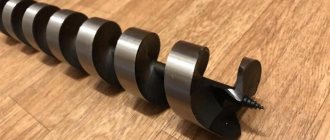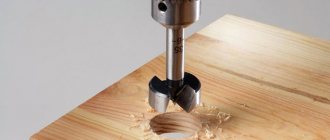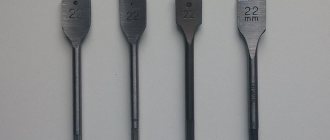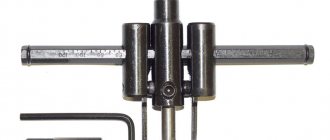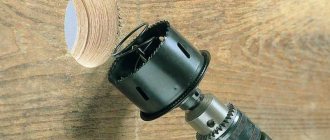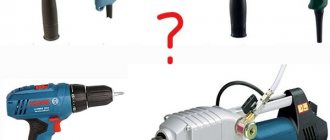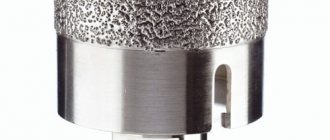How to cut a large diameter hole in a metal plate?
We tell you how to make a homemade circular drill (ballerina) with your own hands for cutting round holes in sheet metal.
We spotted this interesting idea on the YouTube channel “Made in a Garage.”
Necessary materials:
- metal blank;
- round steel bar;
- square bar;
- metal drill;
- fastening hardware - screws.
1
What to sew from
As previously noted, most materials for tilde can be found in any home:
- The doll's body is sewn from opaque fabric without a pattern in beige tones. It is acceptable for it to be white, but then the lady’s dress should be of a different shade. It's better if the fabric stretches. But this is not a necessary condition. Therefore, you can use flannelette, fleece, knitwear, even finely woven linen, etc. The main thing is that the material is dense and does not come apart at the seams.
- For the upper part of the dress (“swimsuit”), use any non-stretchy, non-transparent fabric. These can be not only natural materials, but also synthetic ones. For example, satin, crepe satin. You can use pieces from unnecessary curtains (not tulle), a petticoat, scraps of a blouse. Yes, at least the top part of a child’s white sock. The main condition is that the material is hole-free, clean and without signs of wear.
- For a full skirt, tulle or organza, collected in several layers, is best suited. Even if you don’t have them on hand, they are inexpensive in stores. The only negative is that you have to buy 0.5 m at once - they don’t sell less (unless it’s a specialized tulle ribbon). Long lace will also work. You can make a tutu from the same fabric as the “swimsuit”, although you will have to drape it or make a petticoat.
Technical capabilities
Do-it-yourself Vga adapter
The main use of ballerinas remains cutting sheet material. The ability to adjust the diameter allows you to use one tool for several purposes. Two or more cutting elements allow you to obtain a high-quality processed surface.
Almost any sheet material used in construction, repair and decoration can be processed with a circular drill. Carbon steel gives the structure strength. Special coatings are used to protect against corrosion.
The price range depends on the material of construction and cutting part, manufacturer, size and number of cutting elements.
Design and principle of operation
Do-it-yourself woodworking machine
The design of a circular drill is quite simple and mainly consists of three parts:
- a drill responsible for centering the device;
- a fastening rod of a certain length on which the cutting elements are installed;
- cutters equipped with a device for attaching them to a rod, their number ranges from one to three.
This design is used on single and double cutter models. If there are three cutting elements, then in this case the cutters are fixed on a round disk, and to change the radius they move along the grooves. Additionally, some models can be equipped with a protective cover that protects the working person from flying chips or sawdust. It also protects the worker from being hit by fragments when the device is destroyed.
Now let's see how to drill. The central drill needs to be drilled at a pre-designated point. If the materials are durable, for example, iron, tiles or laminate, then it is better to first mark the drilling location with a regular drill. This is done for convenience so that the “ballerina” does not slip on the surface and scratch the top layer.
Next, we cut a path of the radius we need
Again, here you need to pay attention to the material in which the holes are drilled. If it is a tile, then to prevent damage to the facade surface you need to drill at low speed and lubricate the tile with water or machine oil
This will prevent damage to the tiles and the scattering of fragments. Tile panels must be laid on a flat surface, otherwise they will crack under force.
If the tile is already attached to the walls or floor, then you only need to cut through it, and then replace the “ballerina” with a concrete drill. When drilling laminate or veneer, it is difficult to go through the top layer, but then it goes easier. There are no special instructions for wood, iron, plastic and drywall. The last stage is removing the cut out objects.
In addition to the basic instructions, there are a few additional nuances.
- In no case should you put pressure on the tool or lean on it with your whole body: this can damage the device and split the material in which the hole is made;
- “impact” or “perforator” modes cannot be used, only drilling;
- there is no need to let the “ballerina” overheat: high temperatures can deteriorate the coating of the incisors;
- if drilling is difficult, then you should add speed.
To protect your health when working with a device for drilling circular holes, you need to follow simple rules:
- Before starting work, you need to check whether all components of the device are securely fastened;
- You should wear goggles or a mask to protect your eyes;
- clothing should not contribute to getting into the rotating elements;
- If possible, be sure to install a protective grille on the ballerina.
Specifications
To obtain a high-quality hole of the required size in such cases, you will need a special tool - a ballerina (round drill).
| Tool Options | Parameter values |
| Tool weight | 0.1-0.110 kg |
| Length | 90-120 mm |
| Shank type | Cylindrical |
| Shank length | 8-9 mm |
| Maximum outer circle diameter | 140-160 mm |
| Minimum outer circle diameter | 20-30 mm |
| Diameter of support bar | 7 mm |
| Working surface processing depth | 30 mm |
| Number of working cycles (for ballerina on tiles) | 30-40 |
Characteristics of metal for drill
The ballerina is made of high-quality carbon (tool) steel, which does not contain alloying additives or impurities. Carbon steel is used for the manufacture of high-strength static cutting tools that experience significant mechanical and physical stress.
The properties of carbon steel provide the ballerina with the following characteristics:
| Characteristic | Content |
| Hardness | Ensures that the drill remains in a vertical position when working with it |
| Strength | Ensures uninterrupted operation of the ballerina when drilling deep layers of the working surface |
| Cyclic strength | Maintains performance characteristics after repeated use |
| Plastic | Possibility of adjusting cutters |
| Heat resistance | Possibility of maintaining the working qualities of the tool when drilling at high speeds and heating |
| Wear resistance | Long tool life and resistance to corrosion processes |
Characteristics of a metal drill
The ballerina allows craftsmen to work with metal surfaces (steel, cast iron, brass, aluminum, bronze) up to 14 mm thick. Using this type of drill, mounted in a drill or in a tabletop drilling machine, you can cut a hole with a radius of 22-105 mm in a metal surface.
What is a wood ballerina
DIY wood patina
A circular adjustable ballerina drill is a device that is designed for drilling round holes of large diameter. The tool has a simple design. It consists of a shank with a transverse rod on which movable carriages with cutters are attached. The rod has markings according to which you can set the required spread of the cutters relative to the center of the intended hole. A core drill is fixed in the middle of the shank. It serves as a centering element and support when drilling.
In addition to designs with two cutting elements located symmetrically, there are ballerinas with one cutter or even three. In the latter case, they are located on the base in the form of a disk with grooves.
Types of instruments
In addition to the classic two-cutting version of a circular drill, there are one- and three-cutting models. In the design of a single-cut drill, the cutting part is directly fixed to the rod. The cutter and centering lance are equipped with carbide plates. They make it easier for a ballerina to work on tiles.
Read also: Gas cylinder stove with water circuit
In three-incisor models, the incisors are mounted on a round platform on which there are grooves. The cutters move along these grooves. They have a scale. Correctly set size allows you to cut more accurately and quickly.
Currently, some models are equipped with a protective grille made of plastic. It improves work efficiency and convenience.
The ballerina for metal is equipped with plates made of hard alloy with sharpening of a cutting turning tool. High cutting force dictates the use of stationary or portable radial drilling machines. Basically, holes are cut in galvanized sheets, the thickness of which does not exceed one millimeter.
How to choose and what to pay attention to
Choosing a high-quality circular drill is quite easy
The main thing is to know the main points that you should pay attention to first, but also not to lose sight of the little things
The design is a very important point: a wood ballerina comes with one chisel or two or more. For frequent use, it is better to purchase an option with two or three cutting elements. It is easier to work with such devices and the quality of the processing performed will be at an acceptable level.
It would not be superfluous to be able to replace individual parts. Inexpensive circle drills can have a solid shank with a permanent center drill and rod.
Metal, its quality determines its strength and ability to withstand workloads. High-quality tools are made from high-strength steel or alloys. The shank and cutter holders are shaped using a machine tool. The rod is usually stamped and made of the same metal.
Cheap options often use soft metal or alloys, which can be brittle. Under load, parts may become deformed or break. Such a tool will not last long and it will also be difficult to achieve accuracy from it.
The quality of workmanship, the main feature is the absence of backlashes and distortions. All parts must fit together and be securely fastened with fixing screws.
The markings of a high-quality ballerina's barbell are stamped. Sometimes the divisions are highlighted with bright paint for better visibility.
Cutters and high-quality cutting elements are made from hardened tool steel. They are secured to the holders with rivets or soldering. Solid cutters with holders (made of the same metal) quickly become dull and are not durable.
Manufacturer, when choosing any tool and consumables, preference should be given to well-known and long-proven brands and brands. The most common are Topfix, Stayer, Irwin, Strum.
Purchasing an adjustable circular drill for use at home, or if you need to drill several holes, is completely worth it. This eliminates the need to purchase an expensive tool that may only be needed a few times.
Types of ballerinas
For woodworking
In a home workshop, when working with wood material, you may need a tool for cutting round holes. These tools include a drill, which in everyday life craftsmen who work with wood or wood-based materials call a ballerina. The exact name of this device is a circular drill.
The design of the tool is a bracket, along the axis of rotation of which the drill is fixed. It marks the center of the hole and provides rotational support for the entire fixture. At the edges of the bracket there are two carriages in which the cutters are fixed. The bracket rod is marked, so the carriage with cutters can be installed with high precision. Before starting work, the lateral incisors are moved apart to the required distance. They are pressed to the bracket with screws.
There are other modifications of the woodworking ballerina with one, two or three cutters. The bracket can be replaced with a disk, in special slots of which cutters are placed to adjust the diameter. A hole can be drilled straight or at an angle in the axis into which a cutter is inserted, adjusted with a locking screw. It provides the size of the diameter of the resulting circle.
The tail of the axis can be round or specially shaped for fixation in the SDS chuck. To remove a straight or rounded chamfer, where necessary, knives of various shapes are used.
In addition to wood, the material with which this device works can be drywall, plastic, rubber, tile, or metal.
Drilling drywall
For installation of various equipment in plasterboard with a diameter of up to 100 mm, a ballerina for plasterboard is designed. It is a leg with a centering tip, above which there is a mount for the rod, rotating around its axis. In order to hold the tool, at the end of the central post there is a handle with a notch along the side surface. At the other end of the rod there is a disk cutter.
The device works as follows:
- a tool is drilled in the center of the proposed hole;
- the rod is set at the distance of the required radius;
- The specified hole is cut using circular movements, the edges of which do not require finishing.
The advantage of a ballerina drill for drywall, compared to other tools for the same work, is that:
- the device quickly cuts a hole;
- the disk cutter does not require sharpening;
- despite the intensity of work, all devices do not become loose;
- The rod mount prevents the cutter from moving randomly, changing the cutting geometry.
Tile tool
During construction or renovation work, it may be necessary to make a round hole in the tile. This is necessary for installing a socket, switch, leading plumbing pipes or other elements through the wall.
To work with tiles, single-cut, double-cut and three-cut annular drills are actively used.
The use of these devices promotes a perfectly even cut of tiles without chipping the enamel. By arranging and fixing the cutters at the required distance, you will get a hole of the required diameter and size. Using a circular drill will significantly save time and reduce labor costs. The operation of the instrument is similar to how a ballerina dances.
Drilling process steps:
- On the face of the tile, mark the center of the hole.
- Fix the tile.
- Place the cutters or cutter in the desired position.
- Treat the cut area with machine oil.
- Start carving at low speed.
- To finish the carving, you need to turn the tile over to the other side and continue drilling.
- Use a file to finish the edges of the hole.
Homemade ballerina from bolts and nuts
Many craftsmen use self-made tools in their practice. Therefore, if you are engaged in the manufacture of various products from wood or plastic, then a product such as a “ballerina” made from bolts and nuts, which can be made in a simple way with your own hands, will come to the rescue. Using this device, you can accurately cut holes in wood, plywood, chipboard, MDF and other materials. Let’s look at how and from what to construct such a tool in more detail.
Making a "ballerina"
Such a device can be made either exclusively from bolts and nuts, or using additional metal elements.
Materials and tools
To work, you need to prepare the following list:
- metal plate 4-6 mm thick;
- M8 and M10 bolts in the amount of 2 pcs and 1 pc with nuts and washers for them;
- electric drill;
- Bulgarian;
- cutting and grinding wheel;
- clamps;
- file;
- set of drills;
- bench vice;
- a set of keys;
- ruler and marker.
Step by step process
We make a homemade “ballerina” from ordinary bolts and nuts as follows:
- From a piece of metal plate we cut a workpiece of the required size, 200 mm long.
- We make markings on the plate and determine the center, after which we core and drill a hole with a diameter of 10.5 mm. It is better to perform the procedure on a stationary machine.
- Divide the workpiece in half with a marker and, stepping back 1 cm from the edge and the central hole, core and drill holes. The distance between them should be slightly larger than the diameter of the drill.
- We drill holes on both sides of the plate.
- We clamp the workpiece in a vice and use a grinder to connect the holes into two consecutive grooves. Using a file, we refine the slots for free movement of future incisors in them.
- We fix the plate with clamps to the table or use a vice. We install the grinding wheel on the grinder and round off the corners, edges and clean the surface of the part itself.
- Place an M10 bolt in the center of the workpiece and tighten it from the back with a nut. Screw the second nut on top of the first and tighten it well with a wrench.
- To make working ballerina cutters we use M8 bolts. To do this, we clamp their heads in a vice and cover with masking tape the part of the bolt that should not be processed. After this, use a grinder to remove part of the thread from the bolt.
- Turn the bolt over and perform a similar procedure.
- We sharpen the edges of the cutting elements in the form of a one-sided hook.
- We insert the cutters into the grooves along the edges of the plate. We use washers on both sides and screw on the nut, fixing the elements.
- To be able to set the cutters at the same distance from the center, we make marks on the plate with an accuracy of 5 mm.
- Using a grinder, we make notches on the side of the plate according to the marks. This way, you won't need to constantly update the markup.
- To cut a hole in a workpiece, set the cutters to the specified size, then clamp the tool in the drilling machine and get to work, gradually deepening the cutters into the material.
Circular drill device
A ballerina drill for wood is made from carbon, tool, and alloy steels, which are not suitable for processing hard materials: metal, tile, porcelain stoneware. But they cut drywall and plastic easily.
The two-incisor ballerina looks like an ordinary compass. But the design is much more complex. The bracket and cylindrical shank are manufactured in one piece. There are two holes in the bracket. A centering drill is installed in one. A rod is installed in the second. Both are secured with screws.
To set the required diameter, the cutters move along the rod. It has a vernier scale on it. The tool holders are also secured with screws. The incisors are shaped like a knife. The oblique edge of the cutter should be directed in the direction of rotation, clockwise.
If the drill becomes dull during operation, it can be easily replaced. If the cutters are dull, then, having the skills to work on a sharpening machine, you can refill them. The shank of the structure is fixed in the chuck of an electric drill. It is worth remembering that the small power of a power tool may not be enough to work with a ballerina, unlike metal drills.
Characteristics of a metal drill
A special purpose tool is used to drill a hole in metal. The most popular device is considered to be a one-sided ballerina drill for metal, with a cylindrical axis and cutters with a cutting edge made of pobedite. Before drilling, a hole with a diameter of 0.9 cm is created in the metal for the hook of the tip of the central axis of the circular drill. The device allows you to make a through or blind cavity with a diameter of 40 mm to 150 mm.
For large hole diameters on MDF, plastic, multi-layer plywood, special tools with cutting knives are used to create cavities with a radius of 300 mm. Similar in design, but with excellent characteristics, devices cut ceramic and tiles. Each device model is provided with accompanying documents, which indicate the design features of the equipment and the maximum thickness of the material being processed.
A ballerina for cutting gaskets can most often look like a shank with a flattened cutting part and a screw tip. The feather drill has a high working potential and is produced from alloy steel in different dimensional parameters, allowing you to drill plastic of any thickness.
Adjustable tool overview
Ballerina design
A variety of drills are used to make holes in wood, as well as in wood-based panels (plywood, OSB, fiberboard/chipboard). In this case, the diameter of the groove being formed is limited by the diameter of the drill itself, so that very often the capabilities of standard devices are insufficient.
The solution in such a situation is to use a ballerina - a special drill with movable cutting elements. It has a rather complex design, but at the same time significantly expands our capabilities in drilling holes.
Photo of the most common model
The main elements of the device are:
- The central part, which includes a small diameter twist drill, a “body” in which the cross rod is fixed, and an end piece for clamping into the drill chuck.
- A horizontal bar (often with millimeter markings) along which the cutting elements move.
- Two cutters secured to the rod with hex screws. In preparation for work, the cutters are moved apart to the required width and clamped in a strictly vertical position.
- Ballerinas can also have a simpler design: an L-shaped movable cutter is attached to the central part. However, most often such devices are used not for processing wood, but for drilling tiles or clinker tiles.
Model for tiles with one cutter
An important factor determining the quality of a ballerina is the material from which it is made. Professional tools that are used for processing hardwood are made of high-strength steel with an anti-corrosion coating, and the cutters are equipped with carbide surfacing.
The price of ballerinas without coating is usually lower, but they do not last long, since cheaper metal is used for their production.
Use for drilling holes
One of the obvious benefits of adjustable wood drilling jigs is their ease of use.
The work of making a hole is carried out as follows:
- On a board or sheet of plywood we mark the center of the future groove.
- Using a hex wrench, loosen the mounting screws and install the cutters on the rod so that the distance between them corresponds to the desired diameter. At the same time, we make sure that the cutting elements are positioned strictly symmetrically.
- We tighten the screws with a wrench, fixing the cutters on the rod in the selected position (the distance for most models is from 30 to 120 mm).
- We insert the ballerina into the drill chuck.
- We place the drill at the mark opposite the center (it can be marked with a punch or passed with a drill of a smaller diameter), after which we begin processing. We increase the pressure on the drill gradually so that the load on the cutting edges does not increase.
After the hole is made, we remove the ballerina with a piece of wood or plywood from it. The edges must be filed to remove burrs.
Other tools used for the same purposes
Craftsmen can use several more tools to produce large-diameter holes. When drilling wooden surfaces (the diameter of the required hole exceeds 25 mm), you can use a Faustner drill.
Unlike a ballerina, it has a number of disadvantages:
- A large contact area with the working surface is accompanied by strong heating of the drill.
- It is difficult to align the central tip with the applied markings, because only the outer circle with the working incisors is visible.
- The Fostner drill bit is primarily intended for drilling blind holes (to hide the head of a nail if necessary).
- High price (due to the high heat resistance of the drill).
A hole saw is useful for drilling large diameter holes in hardwood, drywall, brick, and laminated surfaces. Some models of this tool are adjustable; you can set the required diameter yourself. When drilling hard surfaces (stone, porcelain tiles, concrete, tiles), you can use crowns. However, they are already produced with a given diameter. And the master has to buy several pieces of crowns or even a whole set. Such financial costs are not always justified. In addition, when working with crowns, a lot of fragments and construction dust are formed. Therefore, drilling using crowns in an already finished and furnished room is impossible.
Step by step lesson #2
If you want to spice up the decoration a little, try using a suitable photograph or drawn image of a real ballerina as the base:
Print two mirror copies of the same picture (you can rotate it 180 degrees around the vertical axis using almost any graphics editor). Cut and glue them together so that the finished figure is double-sided. We used this vintage image (clicking on the image will open the photo in full size, which you can use in your work):
While the base dries, cut out two identical rectangles from thick paper. Fold them like an accordion, then bend the resulting workpiece in half:
Glue the edges of the paper to each other on the inside of the folded accordion. When opened, the resulting “fans” should completely cover the hem of the drawn ballerina. Now you need to glue the blanks to the figure. Slightly unscrew the outer edges of the accordion and give the pack a curved shape. Apply a little glue to the edges and press them to the edges of the base. Glue the second “fan” on the other side of the figure.
To give the pack even more volume, you can attach another thin tissue paper on top of the first skirt:
To make a pendant, poke a small hole in the top of the figurine and thread gold or silver thread through it.
Ballerina made from napkins
And finally, the most unusual lesson! If you have a piece of thin wire and a napkin on hand, you can make a model like this:
To begin, twist the wire into a basic silhouette of a man with his arms raised.
Next, divide a regular table napkin into layers (usually there are 2 or 3). If there was a bright design on the front side, use this layer for something else, it will not work for our project.
Set aside a few untouched layers of paper and tear the rest into strips about 3 cm wide
It is very important to do this by hand and not with scissors. Take the wire “skeleton” and start wrapping it with strips of paper
As the paper covers the figure, apply colorless office glue diluted with water over it.
By wrapping several additional layers of paper around the upper part of the body, make a slight thickening to make the figure of the toy ballerina more reminiscent of a human. After the figures are completely dry, you can start dressing.
Fold one of the set aside squares as if you were going to cut a snowflake out of it (see previous instructions), measure the desired length of the dress and trim off the excess paper from the wide side. It's better if you make the cut line slightly wavy.
Holding the paper at the intersection of all the folds, tightly roll and unfold the workpiece clockwise several times, and then do the same in the opposite direction:
Two-layer skirts look more delicate, so don’t be lazy to repeat this procedure with another layer of paper napkin.
After carefully making small holes in the paper for the ballerina's head and arms, put the dress on her. Using a white thread, tie it at the waist
And this is what happened:
If you still have any questions, watch this video for greater clarity and for new ideas:
https://youtube.com/watch?v=HXjznuqWpXU
How to make a “ballerina” for cutting circles in soft sheet materials
Hello, dear readers and DIYers!
When making various parts for homemade products, sometimes you need to cut a large round blank or hole in a soft sheet material such as leather, rubber, paronite, cardboard.
In this article, the author of the YouTube channel “TEXaS TV” will tell you how he made a simple hand tool to perform these tasks.
Despite the lathe used in the manufacture of some parts, this tool can be made without turning.
Materials. — Round steel, rod — Old drills, M3 screws — Sheet paronite — Abrasive polishing paste, felt, sandpaper — Two-component epoxy glue, machine oil.
The author makes the cutter and needle from a pair of old 6 mm metal drills.
Now radial holes are drilled in the holders for screws that will secure the cutter and needle. Then an M3 thread is cut into them.
A transverse hole for the rod is made in the upper part of the holders. Moreover, in the needle holder it will be deaf, and a thread is cut in it.
In the second, slider holder, it will be through and have a diameter of 8 mm. In addition, a 6-mm axial hole is drilled into it, and an M8 thread is cut into it from the tail part.
Of course, such a tool can also work with plexiglass, you just have to change the shape of the cutter.
I thank the author for implementing a tool for cutting circles and large holes in sheet materials.
Good mood, good health, and interesting ideas to everyone!
The author's video can be found here.
Source
How to make a ballerina out of paper
First of all, you will need to choose the silhouette of a beautiful ballerina to cut out. The Internet is full of options. To make the figure voluminous, the skirt (tutu) is made separately.
What you will need:
- ready-made templates;
- sheets of paper (white, colored);
- scissors;
- pencil, eraser (circle);
- felt-tip pens, pencils or paints (to color the paper silhouette);
- rope or ribbon (if the craft is for a Christmas tree).
Manufacturing process
The step-by-step master class will begin with choosing a suitable picture. There are several options. The first is that you need an ordinary white silhouette, a colored ballerina or a real person. The last option is used when a person’s face cut out from a photograph is glued onto a finished paper craft. The craft is placed inside a holiday card or made into a Christmas tree toy. An original New Year's gift.
For a colored ballerina, you can either choose a picture of a dancer and print it out and cut it out. Or take a regular white outline and then color it using markers or paints. It is not necessary to carefully draw the details; light strokes are enough, especially if the author is not a very skilled artist. You can put such a ballerina on a postcard with your own hands. All that remains is to fill out the wishes inside.
To make the image two-dimensional and viewed equally on both sides, print two identical, but mirrored pictures. Then glue them together with the wrong side. Then the figure will be double-sided. Excellent Christmas tree toy.
Pack. The dress looks more impressive. The easiest way is to cut out a paper snowflake for the pack. Carefully make a small hole in the center or cut to the center to attach the snowflake skirt to the ballerina silhouette. Then glue the cut out part. This tutu looks beautiful and gives the dancer’s image a special charm.
White silhouette or black? If you want to make a garland of several silhouettes of ballerinas, you don’t have to make them white. Take sheets of colored paper and choose colors that match each other. Two or three for contrast. For example, white-black-blue or green-red-gold. By the way, if the garland will be a festive decoration, it is better to take classic colors.
Then the craft will convey the spirit of the event. Carefully attach the cut out ballerinas to a thread and hang them together on one ribbon or strip. Or tie it to one long thread. Then it will seem that the dancers are floating weightlessly.
https://youtube.com/watch?v=tShap4a1pUc
Paper ballerina - an elegant decoration and an original souvenir
Making paper crafts has been very popular lately, because with the help of the simplest paper you can make very unusual and beautiful things with your own hands. For example, a seemingly simple ballerina without any bright decorations, simply cut out of white paper, can become an interesting decoration for a New Year tree or a birthday, can decorate a banquet wedding hall, or simply become a souvenir for your best friend. If, on top of that, your friend turns out to be a ballerina or a devoted fan of this art, a DIY paper ballerina will be the most amazing gift.
- Using a simple process of cutting out a ballerina from paper, you can decorate a window very beautifully and interestingly before the New Year. To do this, just cut out a template or stencil and stick it on the window using tape or PVA glue.
- You can make a paper ballerina three-dimensional and use them to create a real aerial ballet, soaring high under the ceiling.
- You can make an unusual New Year's garland from several paper ballerinas. To do this, print out templates of ballerinas from paper on a printer, come up with bright and interesting outfits for them and place them on a cord or beads, then hang them on the Christmas tree or on the wall.
- Snowflakes are the main decoration of the New Year tree and the New Year's interior of an apartment or house. Sometimes, together with your child, you want to come up with the most unusual and fabulous snowflake that cannot be found anywhere else similar. In this case, you can make ballerina snowflakes that can easily decorate any room or Christmas tree.
- If you have been interested in paper crafts for a long time, you can make a paper ballerina using the quilling technique. As a result, you will have an original and bright souvenir or Christmas tree decoration in your hands.
- To create beautiful paper ballerinas, you don't need to go to the store for intricate materials or search for something on the Internet for a long time. It is enough to have on hand several sheets of white paper, some waste organza or other airy fabric, scissors, various templates or stencils and, of course, your imagination and inspiration.
Making a ballerina cutter
A ballerina drill significantly saves time when processing (milling) the contours of a cut hole. Processing is carried out automatically using power tools (drill, hammer drill).
Therefore, the physical effort expended when working with a ballerina is also insignificant. Given these advantages, home craftsmen want to have such a tool in their workshop. Moreover, making a ballerina with your own hands is not at all difficult for a competent craftsman.
For this you will need materials:
To work you will need tools:


